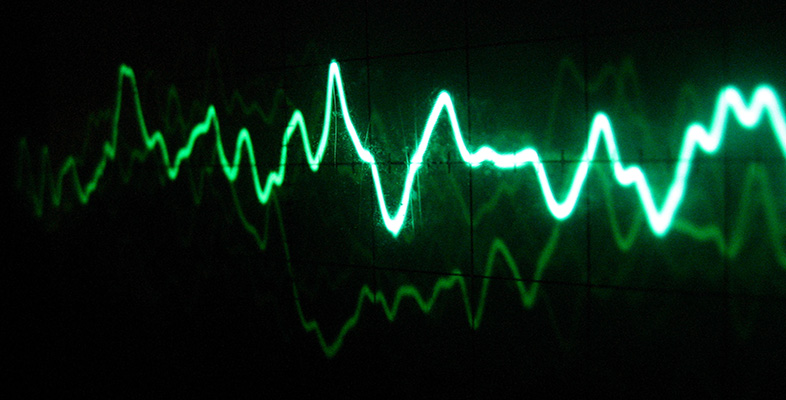2.3 Pressure waves and cycles
In this section we shall be looking at the behaviour and properties of pressure waves in the atmosphere.
Sound originates from the motion or vibration of an object. Let's look at an example of a sound wave generated by a vibrating tuning fork. The prongs of the tuning fork move backwards and forwards cyclically. A cycle is a complete series of movements up to the point where the movement starts to repeat itself. As the prongs of the fork vibrate back and forth they push on neighbouring air particles. The forward and backward motion of a prong alternately pushes air molecules together and then pulls them apart. When the molecules bunch together the local air pressure increases then as the prong retracts backwards a region of low pressure is created allowing the air molecules to move back to the left. Because the tuning fork is vibrating regularly, the result is a regular pattern of pressure variations, of high pressure regions where the air particles are compressed together and low pressure regions where the air particles are spread apart. This pattern of pressure variations moves away from the tuning fork. Hence the sound wave consists of a repeating pattern of high pressure regions and low pressure regions passing through the air and is sometimes referred to as a pressure wave. A different tuning fork might vibrate at a different rate. If a second fork vibrates at twice the rate of the first, the pressure variations woould be squashed together. The pressure wave, however, still travels at the same speed away from the fork.
Figure 4 shows that a vibrating object, a tuning fork, creates alternating regions of high and low pressure. These alternating pressure regions travel away from the fork in all directions, though we shall concentrate on only one direction.

In reality, molecules are not neatly arranged in rows and columns in the way represented in Figure 4. These representations are therefore simplified images of what is happening at the molecular level. They are nevertheless a convenient way of showing the bunching up and spreading out of molecules created by the vibration of the tuning fork's prongs.
A regular pattern of high- and low-pressure regions like this is known as a pressure wave. Because the wave travels away from its source, it is also known as a travelling wave, to distinguish it from another type of wave, the standing wave. Note that not all travelling waves are pressure waves. Light, for instance, is a travelling wave but not a pressure wave.
Among other things, a travelling wave is a way of transmitting energy. In the case of the tuning fork, the energy imparted to the tuning fork when it is made to vibrate is conveyed by the pressure wave into the environment. If the tuning fork were suspended in a vacuum and had no mechanical connection to anything else, it would not only be inaudible but it would also continue to vibrate for much longer because there would be nothing to transfer its energy into the environment.
Notice that although the pressure wave travels away from the tuning fork, the molecules do not travel away from the fork, at least not in the long term. In the simplified representation of Figure 4, each molecule moves regularly backwards and forwards about a fixed point. Motion such as this, which repeats itself regularly, is known as cyclic (or cyclical) motion, or oscillatory motion. One cycle or oscillation is one complete sequence of motion up to the point at which the motion starts to repeat itself. (The motion of the tuning fork's prongs is also cyclic or oscillatory.)
As a final characterisation of the type of wave we are dealing with, notice that the oscillations of the molecules are back and forth along a line that is also the direction of travel of the wave. The wave is said to be longitudinal for this reason. There are other kinds of wave, and you can learn about them in OpenLearn unit T212_2 Creating musical sounds, where the oscillation in the medium is at right angles to the direction of the wave's travel. These are known as transverse waves. An example can be seen in the ripples on the surface of water: the water oscillates up and down as the wave radiates outwards from the source.
Activity 6 (Self-Assessment)
Below are three true statements (1 to 3).
Sound waves are pressure waves.
Sound waves emanating from a single source in the open (away from buildings etc.) are travelling waves.
Sound waves are longitudinal waves.
Here are three explanations ((a) to (c)) of the above statements. These are in the wrong order. Which explanation goes with which statement?
(a) Because the molecular oscillations are along the line of travel of the wave.
(b) Because the pressure variations radiate outwards from their source, conveying energy away from the source.
(c) Because they consist of cyclical changes of pressure.
Answer
The following are the correct pairings:
1 and (c)
2 and (b)
3 and (a).
The following is the correct text:
Sound waves are pressure waves, because they consist of cyclical changes of pressure.
Sound waves emanating from a single source in the open (away from buildings etc.) are travelling waves because the pressure variations radiate outwards from their source, conveying energy away from the source.
Sound waves are longitudinal waves, because the molecular oscillations are along the line of travel of the wave.
